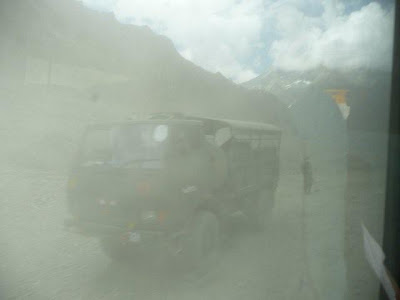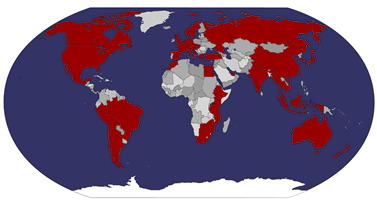
434km of fun
First thing in the morning, I switch on the TV. It’s strange, the India on TV just doesn’t exist! Flashy adverts show swish shopping centres, stock exchanges, wifi-enabled cities. Where are these places? What does your average family think watching Bollywood films with huge mansions, helicopters, glassy offices? Anyway, we head downstairs to check out. The front door of the hotel is locked and all the staff are asleep. I did tell you Indians don’t get up early, didn’t I? We wake up reception, hand over the key, and tell him that we haven’t stolen the remote control for the TV.

Check the troops at the bottom
Walking to the station, it’s pleasantly quiet. Arriving there, we find our J&K State bus. Luggage goes up on top, for which I have to tip an old senile chap. I’d almost handed my bag up to the person on the top when he stopped me, made me put my bag down, then he picked it up, handed it up, and asked for money! Welcome to India!

Super Deluxe!
We leave late, but not too much. On board we have a Slovak couple, an American and Russian girl, and a British couple. Our seats are on the left, and not too bad, in the middle of the bus with a window we can open.

The bus heads out of town towards the mountains.

Indian Army guarding important Pooh figurine, presumably for “security purposes”
First town is Sonamarg (Meadow of Gold), famous for the Thajiwas Glacier.

It’s a lovely green (the Sind) valley with steep rocky walls, with a real “Alpine” feel, and I’d happily stay here a few days.

Unfortunately it’s home to Kashmir’s largest Army base, and the security situation prevents much trekking. We enjoy masala dosas and tea in the sunshine.

Moving on, we pass the “High Altitude Warfare School”, motto 'Respect all, suspect all.'

Rock climbing class. No photos allowed the instructor yells at us.
The landscape gets rockier and more dramatic as we ascend.

We pass bearded goat herders and Central Asians, nomads in tents who stare as we rumble past, kicking up dust (the windows on the bus get lots of action, as it’s hot so we want them open, but depending on the breeze direction and any passing traffic, a big dust storm is kicked up, and all windows quickly closed).

As we ascend towards the Zoji-la, the high pass at 3530m, we pass chunks of ice at roadside. The bus winds up switchbacks, high above the deep glacial valleys where wild horses roam free. The road is cut into sheer rock, and we’re often only inches from a couple of thousand feet drop.

Sometimes there are signs saying “Go slow, sinking zone ahead”. It’s one way, with a convoy system dictating which way the traffic flows. Arrive at the wrong time and you could have to wait several hours or even overnight before proceeding. A sign we pass says “Happy Amarth Yatra” from Border Roads Division. There seems to be an army division called Beacon, who are responsible for this road. “Beacon, the Mountain Tamers” one sees every so often on signs or marked out with rocks on the hillside.

“Now India is a place beyond all others where one must not take things too seriously - the mid-day sun always excepted.” – Rudyard Kipling.
We pass Zoji-la, and so now are in Ladakh, yay! Then stop at army Camp Gumri to register. I try to take a photo of a mountain in the distance, but an army type barks at me “No photos Sir”, tapping his stick on the bus side. We drive on, and I get several good photos of the tents and a couple of canisters of oil that I’m sure the Pakistani Intelligence will find very useful when I send them through.

The Indian Army don’t want you to see this!
Onwards to Drass, supposedly the second-coldest inhabited place on earth (though all Indian claims of this nature need to be taken with a pinch of salt). The Dard inhabitants have continuous heavy snowfall and temperatures of -40C every winter.

This town suffered heavily in the 1999 war as it’s very close to the Line of Control, the “border” currently held between Pakistan and India. In fact the road we are on follows this line for the next few hours drive, to Kargil and past. As far as I can work out, it must be just the other side of the ridge that is to our left. This is the most risky part of our journey, as we’re well within range of Pakistani shells, and in 1999 this was what happened – they attacked this road, Drass and Kargil, where we’ll stay tonight. Supposedly though if the situation is too risky they don’t allow tourists along here anyway.

Sheep tumble down the dusty rock face in front of our bus, forcing the driver to slam on the brakes. Where are they coming from?! More dust storms force us to keep the windows shut, as we pass wrapped up dark-skinned Bihari workers improving the road. They’re apparently paid 80r plus food and lodging, which is enough to lure them away from poverty-stricken Bihar in the plains. We cross muddy torrential rivers passing underneath bridges marked as weak! Then, a fantastic game of cricket, a strange sight in the high plains about 4000m up!

High-altitude cricket!
At Drass we stop, and have to register our passports, more pointless paper, including inventing places we’ll stay at etc. None of the information is checked, of course.

At the café, I have tea, and at the conductor’s suggestion have local salty tea. Ugh! It’s horrible!! How do people drink tea with salt in, it’s just wrong!

Bloomin’ hot!
We’ve got two hours more to Kargil now, or 56km!
'If a youth would be distinguished in his art, art, art, He must keep the girls away from his heart, heart, heart.' – Rudyard Kipling.

The highways in Ladakh are all lined with cute feel-good / instructional signs, in yellow. Here are a few examples:
Drink and drive, you won't survive
This is highway not runway
Run on horsepower not rum power
There is money, but life is precious
Hard work is the best investment man can make
Hurry makes worry
Driving with whisky is risky
And slightly racy for India:
I am curvatious, go slow
Go slow on my curves
In Kargil, we’re told that the bus will continue the next morning at 5am. Ouch. We head off as a group looking for rooms. Army convoys heading through make crossing the road hard. The first hotel is full, a bit of a shock. Apparently the town is busy as the road has been out for a week due to a bridge being down, and only re-opened a couple of days ago. Next we try LP-recommended Evergreen, which has a room for 500r, not very cheap but the town is busy, and we’re too lazy to keep looking, so we take it. It’s clean, and has hot water.

The town is small, and not very pleasant.

There are few restaurants or cafes, and those are grubby and dark. Internet is 80r per hour (little do we realise that in Leh it’ll be 90!). We eat together in Zoji-la Restaurant, which is a ridiculous place, with almost no food (we work through the menu trying to order being told that everything is unavailable), and the food takes forever to come.

Whilst we wait, Olly (English chap) and I go out for some roadside bbq meat wrapped in newspaper.

When the food finally comes, it’s not good. Soups are powdered soups, with lumps of powder not even stirred in properly.

We all retire.
Our hot shower is just a trickle, but it is a shower. We try to sleep.

“'That's a good man,' he said. 'If all goes well I shall work him - hard.' This was Jim Hawkin's notion of the highest compliment one human being could pay another. “ - from William the Conquerer, a short story by Rudyard Kipling.
Despite requesting it, we get no wake-up call! I do have funny dreams though, possibly due to the altitude (2650m). We do however experience the Islamic call to prayer right outside window. I wouldn’t mind so much if any of the local muslims paid any attention to it, but all it does is disturb us half an hour before we need to get up.
To the bus, and in the still-dark street we bump into the others. By 4:50 all foreigners are sitting waiting on the bus. Not a single Indian. The conductor chap says we'll leave at 5am even if not everyone is here. Ooh, except the guy who comes 20 minutes late in a police car, we'll wait for him. We wonder how much locals pay for the same ticket we have, probably a third.

We enter the desert as the sun comes up.



The bus stops for tea but I’m too tired to get off for it. The music playing in the bus is strange Arabic chanting, which seems appropriate as we wind our way between sand dunes. We’re on the left of the bus, and I start to wonder whether this is the right side. Obviously you tend to notice more when the scenery is on the other side – certainly I felt like the right had the better dramatic landscapes – so if you’re taking this bus, sit on right for Srinagar to Leh, left for other way.

Damned views on the other side
The landscape is very dry, and yet there are oases where irrigation had been used, channelling water running off the distant mountain-tops, carrying it for some distance in some cases.

We pass a large army base, the first for while – perhaps this is because we are now pulling away from the contentious Line of Control. I wonder how on earth people first found this route which weaves back and forth between ridges and mountains?!


Lunch
Lunch stop, and we have Dal Bhat and tea, plus enjoy a pit toilet which was cleaner than most to be fair, with a “flush” system of a spade with some dust. Around here everywhere is selling apricots and Leh berry juice.

Apricots are apparently the local fruit of choice, and all of it gets used, from fresh fruit, juice, dried fruit, oil from the seeds etc.

Now we only have 97km left, or in time terms, four hours!! Every time we stop the bus is plagued with flies for next half an hour – I try where possible to swat the buggers out of the window.


Our bus companions are American girl, Russian girl, British couple and Slovak couple. Also a Spanish couple who keep themselves to themselves. Rest of the passengers are Indians, who smile but don't otherwise talk to us much.


The front of the bus, next to the driver, seems to be a transition place – we occasionally pick up people that the conductor seems to know and carry them short distances. At one village we pick up a dozen school girls and take them to the next.

Conductor instructs us at each stop how long, what we're here for (another pointless passport registration, lunch, tea or just a toilet stop). Stops are very erratic - sometimes coming within an hour of each other, others every four hours. Makes planning liquid consumption difficult, so I think we're all fairly dehydrated.

Lamayuru Gompa
Criminals could once claim sanctuary here – its former name is Tharpa Ling or Place of Freedom. It’s perched on an eroded crag over a drained lake with eroded creamy rock that is called moonland by locals.

We munch nik nak equivalents called Kurkure. And at the last stop, I found some frozen sparkling water, Haywoods 5000, which is also a beer. It’s wonderful, so cold and refreshing!

Beacon road builders appear to have handed over to Project Himank, the road builders of Ladakh, who also advertise themselves periodically along the road.

Just getting these boulders out of the way for you..
Leh
Arriving in Leh bus station, there’s not much hassle – one guy with a hotel, and a taxi guy. Almost too easy. We walk up into town.

City gate
This is the capital of Ladakh, lying nestled among low hills on the north side of the Indus Valley, between the Stok Mountains to the south and the Ladakh Range to the north.
“There is nothing whatever to do. That is Leh’s charm… nothing to do but to slow down, relax, laze, to become one vast transparent eye.” Andrew Harvey – A Journey in Ladakh.

Stupa action
Our mission is to get to the post office, to post Supi’s wax, after two weeks of lugging it about India! It’s moved from the Main Bazaar street to an information centre nearby. They’re closing in 10 minutes, and can’t wrap it for me. They suggest I find a tailor. I run out and find one in a side alley. They stitch together some offcuts of material to make a bag for the wax. 20r. I only have 15 or 100, they take the 15, though I find them a few days later and give them another 10. Seconds before the office closes, I finally send the damn parcel! Hurrah!

We walk up towards Changspa, an area north of the centre of town, to find a place. We pass lots of amusing international hotel chain rip-offs - Le MeridiAn, Holiday Inn etc. Quite far along, over a strange decrepit metal bridge, we reach my first choice, Asia Guest House. Initially I miss the door, but eventually we’re in, like the room and the beautiful garden full of vegetables and flowers, so we stay.

Asia Guesthouse’s lovely garden
Only complaint in general is that hot water is only in the morning.


Limited but pretty view
One of my first purchases on arriving in Leh is Trailblazer’s Trekking in Ladakh guide. These are excellent books, with lots of interesting information, and trek guides with hand-written maps. (Sunday Times “They are particularly strong on mapping” – although the competitor is LP, and we know what they’re like on mapping!). Anyway, I’ve lifted lots of snippets out of it.
Heading out, we meet a Nepali chap called Samir who works at Oasis Garden restaurant. He will head down to Goa soon as the season is ending here. He also tells us that internet is 90r everywhere here, even for locals. We wander up to Karzoo to the restaurant whose advert we saw previously, Ame Go, a Korean restaurant and café.

It’s off the main road in a small alley, but not difficult to find. Inside it’s cosy, more like someone’s garden than a café. Heejung is the cook, and she has a Ladakhi girl helping her. It takes a while before we get a menu.
We go for two kimchi jjigae sets, with Korean green tea. 200r each for the set, but you get lots of food, and we happily demolish it all, to Heejung’s surprise.

Thank-you Jina!
We’ll be back! Leaving, we meet a local chap, Engineer Lassu, who takes us up the alley to higher ground where we can see the sunset and have a nice view.


We say goodbye, and walk down to town, Thuzar being hassled by a couple of cows wandering the lanes. Either side there is barley and wheat growing – too cold for rice here. This would also explain why Tibetan food is bread based.

Plenty of sunflowers everywhere
In town, we go for a beer at La Terrace, a restaurant overlooking the busy junction. First we try a Mona Lisa beer, which is not so nice, so we switch to more reliable Kingfisher!

After a pleasant walk back to Changspa we pop into La Pizzeria restaurant, not for pizzas, but because it has a nice outside garden area with a view, though it’s dark now so it’s more moon and stars. Here we try a Godfather, which as the name suggests is the local strong beer, then again, back to Kingfisher.

By the way, they have Kingfisher mineral water here, so a litre of Kingfisher isn’t necessarily a bad thing!





2 comments:
Hi,
There is an online bus ticketing portal called www.redBus.in. I noticed that you have mentioned about Indians paying less compared to visitors for the bus tickets.
I would like to highlight that the said wenbsite sells bus tickets at the same price to foreigners as they do to Indians. All this is done in a transperant manner. You can book tickets online at the portal www.redBus.in
Hope this information proves useful to your readers.
Warm regards
Abey
Hi! Sometimes I think that my life has no sense, but when I visit blogs like yours I find myself happy. Keep writing on.
Post a Comment